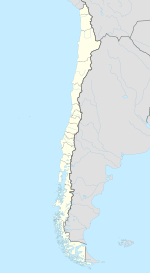Angol, Chile
|
Angol Angol de los Confines |
|||||
|---|---|---|---|---|---|
| City and Commune | |||||

Plaza de Armas de Angol
|
|||||
|
|||||
| Coordinates: 37°48′S 72°43′W / 37.800°S 72.717°WCoordinates: 37°48′S 72°43′W / 37.800°S 72.717°W | |||||
| Country | Chile | ||||
| Region | Araucanía | ||||
| Province | Malleco | ||||
| Founded | 6 December 1862 | ||||
| Government | |||||
| • Type | Municipality | ||||
| • Alcalde | Obdulio Valdebenito Burgos (Concertación) | ||||
| Area | |||||
| • Total | 1,194.4 km2 (461.2 sq mi) | ||||
| Elevation | 65 m (213 ft) | ||||
| Population (2012 Census) | |||||
| • Total | 51,268 | ||||
| • Density | 43/km2 (110/sq mi) | ||||
| • Urban | 43,801 | ||||
| • Rural | 5,195 | ||||
| Sex | |||||
| • Men | 23,770 | ||||
| • Women | 25,226 | ||||
| Time zone | CLT (UTC−4) | ||||
| • Summer (DST) | CLST (UTC−3) | ||||
| Postal code | 4650000 | ||||
| Area code(s) | country 56 city 45 | ||||
| Climate | Csb | ||||
| Website |
www |
||||
Angol is a commune and capital city of the Malleco Province in the Araucanía Region of southern Chile. It is located at the foot of the Nahuelbuta Range and next to the Vergara River, that permitted communications by small boats to the Bío-Bío River and Concepción. This strategic position explains the successive foundations of this city during the Arauco War. It was first founded in 1553 as a "conquistador" fort of Confines, the fort was later destroyed and rebuilt several times and it was not until the Pacification of Araucania in the late 19th century that it was rebuilt with the name of Angol. The city has a current population of approximately 49,000. Within the electoral divisions of Chile, it belongs to the 48th electoral district and the 14th senatorial circumscription.
Modern Angol was first founded in 1553 as the conquistador fort of Los Confines by Pedro de Valdivia, the fort was later that year abandoned and destroyed by the Mapuche after the Battle of Tucapel. In 1560, the city was established by Governor García Hurtado de Mendoza with the name of San Andrés de Angol, after his father the viceroy of Peru, the location to the north of the site of the old fort. It was commonly called Ciudad de Los Infantes for the infantrymen that had been assigned to build the city.
...
Wikipedia



